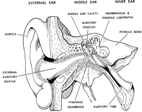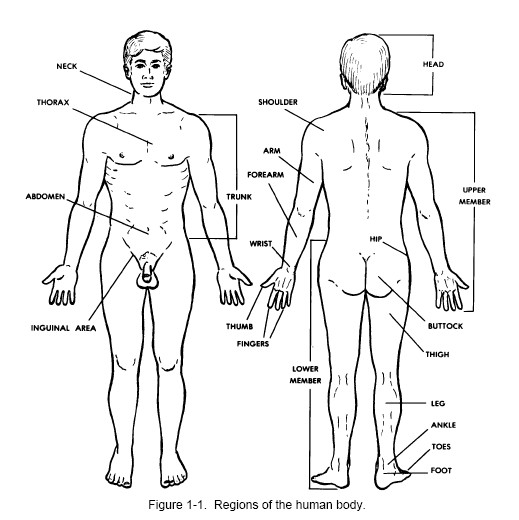INTRODUCTION
1 INTRODUCTION
TO BASIC HUMAN ANATOMY
I. General
II.
Anatomical Terminology
III. Cells
Exercises
2 TISSUES OF
THE BODY
I. General
II.
Epithelial Tissues
III.
Connective Tissues
IV. Muscle
Tissues
V. Nervous
Tissue
Exercises
3 THE HUMAN
INTEGUMENTARY AND FASCIAL SYSTEMS
I. General
II. The
Human Integumentary System
III. The
Fascial System of the Human Body
IV. Serous
Cavities of the Human Body
Exercises
4 THE HUMAN
SKELETAL SYSTEM
I. General
II. Bone As
An Individual Organ
III.
Arthrology--The Study of Joints (Articulations)
IV. The
Human Skeleton
Exercises
5 THE HUMAN
MUSCULAR SYSTEM
I. The
Skeletal Muscle
II. Some
Elementary Skeleto-Muscular Mechanics
Exercises
6 THE HUMAN
DIGESTIVE SYSTEM
I.
Introduction
II. The
Supragastric Structures
III. The
Stomach
IV. The
Small Intestines and Associated Glands
V. The Large
Intestines
VI.
Associated Protective Structures
Exercises
7 THE HUMAN
RESPIRATORY SYSTEM AND BREATHING
I. The
Respiratory System
II.
Breathing and Breathing Mechanisms in Humans
Exercises
8 THE HUMAN
UROGENITAL SYSTEMS
I. The Human
Urinary System
II.
Introduction to Human Genital (Reproductive) Systems
III. The
Human Female Genital (Reproductive) System
IV. The
Human Male Genital (Reproductive) System
Exercises
9 THE HUMAN
CARDIOVASCULAR AND LYMPHATIC SYSTEMS
I.
Introduction
II. The
Human Cardiovascular System
III. The
Human Lymphatic System
Exercises
10 THE HUMAN
ENDOCRINE SYSTEM
I.
Introduction
II. The
Pituitary Body
III. The
Thyroid Gland
IV. The
Parathyroid Glands
V. The
Pancreatic Islets (Islands of Langerhans)
VI. The
Suprarenal (Adrenal) Glands
VII. The
Gonads
Exercises
11 THE HUMAN
NERVOUS SYSTEM
I.
Introduction
II. The
Neuron and Its "Connections"
III. The
Human Central Nervous System.
IV. The
Peripheral Nervous System (PNS)
V. The
Autonomic Nervous System (ANS)
VI. Pathways
of the Human Nervous System
VII. The
Special Sense of Smell (Olfaction)
VIII. The
Special Sense of Taste (Gustation)
IX. The
Special Sense of Vision (Sight)
X. The
Special Sense of Hearing (Auditory)
XI. The
Special Sense of Equilibrium (Balance)
XII.
Controls in the Human
Nervous
System
Exercises
--------------------------------------------
LESSON 1
INTRODUCTION TO BASIC HUMAN ANATOMY
Section I. GENERAL
1-1. DEFINITIONS
a. Anatomy is the study of the structure of the body.
Often, you may be more interested in functions of the body. Functions
include digestion, respiration, circulation, and reproduction.
Physiology is the study of the functions of the body.
b. The body is a chemical and physical machine. As
such, it is subject to certain laws. These are sometimes called
natural laws. Each part of the body is engineered to do a particular
job. These jobs are functions. For each job or body function, there is
a particular structure engineered to do it.
c. In the laboratory, anatomy is studied by dissection
(SECT = cut, DIS = apart).
1-2. BODY TYPES
No two human beings are built exactly alike, but we
can group individuals into three major categories. These groups
represent basic body shapes.
MORPH = body, body form
ECTO = all energy is outgoing
ENDO = all energy is stored inside
MESO = between, in the middle
ECTOMORPH = slim individual
ENDOMORPH = broad individual
MESOMORPH = body type between the two others,
"muscular" type
Ectomorphs, slim persons, are more susceptible to lung
infections. Endomorphs are more susceptible to heart disease.
1-3. NOTE ON TERMINOLOGY
a. Each profession and each science has its own
language. Lawyers have legal terminology. Physicians and other medical
professions and occupations have medical terminology. Accountants have
debits, credits, and balance sheets. Physicists have quantums and
quarks. Mathematicians have integrals and differentials. Mechanics
have carburetors and alternators. Educators have objectives, domains,
and curricula.
b. To work in a legal field, you should know the
meaning of quid pro quo. To work in a medical field, you should know
the meanings of terms such as proximal, distal, sagittal, femur,
humerus, thorax, and cerebellum.
1-4. KINDS OF ANATOMICAL STUDIES
a. Microscopic anatomy is the study of structures that
cannot be seen with the unaided eye. You need a microscope.
b. Gross anatomy by systems is the study of organ
systems, such as the respiratory system or the digestive system.
c. Gross anatomy by regions considers anatomy in terms
of regions such as the trunk, upper member, or lower member.
d. Neuroanatomy studies the nervous system.
e. Functional anatomy is the study of relationships
between functions and structures.
1-5. ORGANIZATION OF THE HUMAN BODY
The human body is organized into cells, tissues,
organs, organ systems, and the total organism.
a. Cells are the smallest living unit of body
construction.
b. A tissue is a grouping of like cells working
together. Examples are muscle tissue and nervous tissue.
c. An organ is a structure composed of several
different tissues performing a particular function. Examples include
the lungs and the heart.
d. Organ systems are groups of organs which together
perform an overall function. Examples are the respiratory system and
the digestive system.
e. The total organism is the individual human being. You are a
total organism.
From Basic
Human Anatomy


